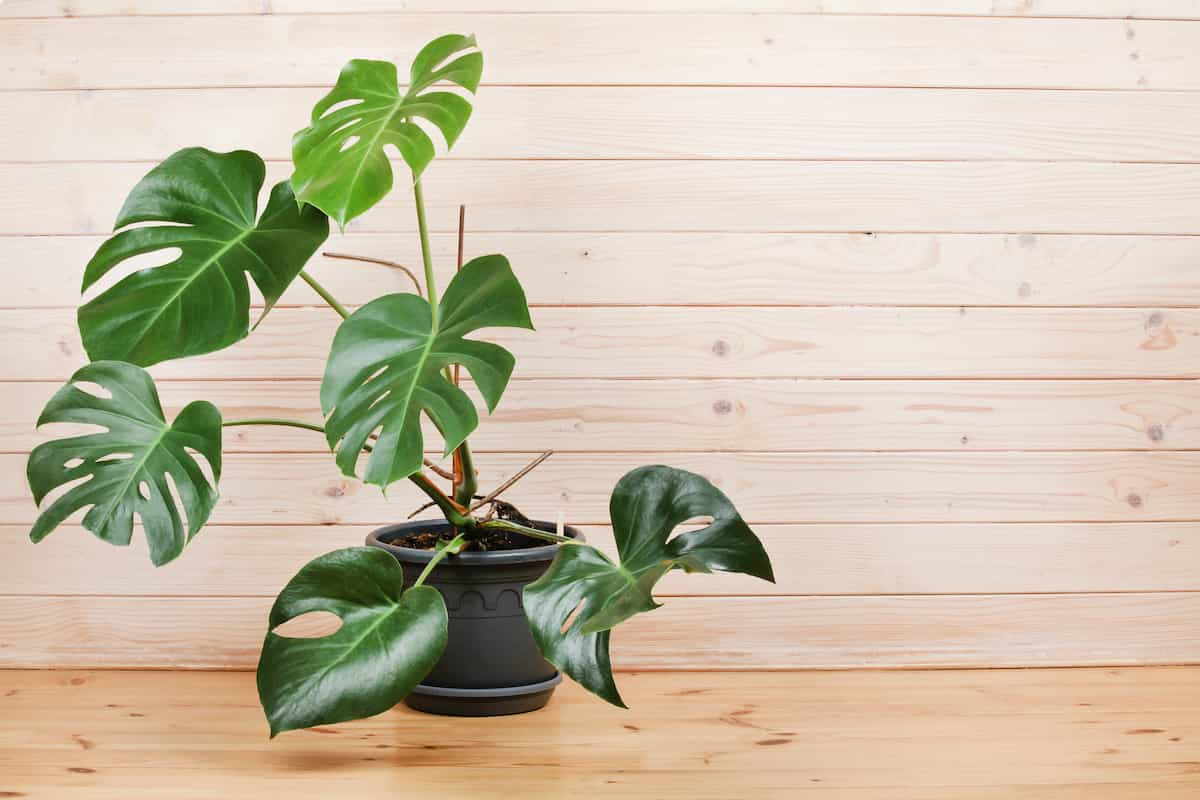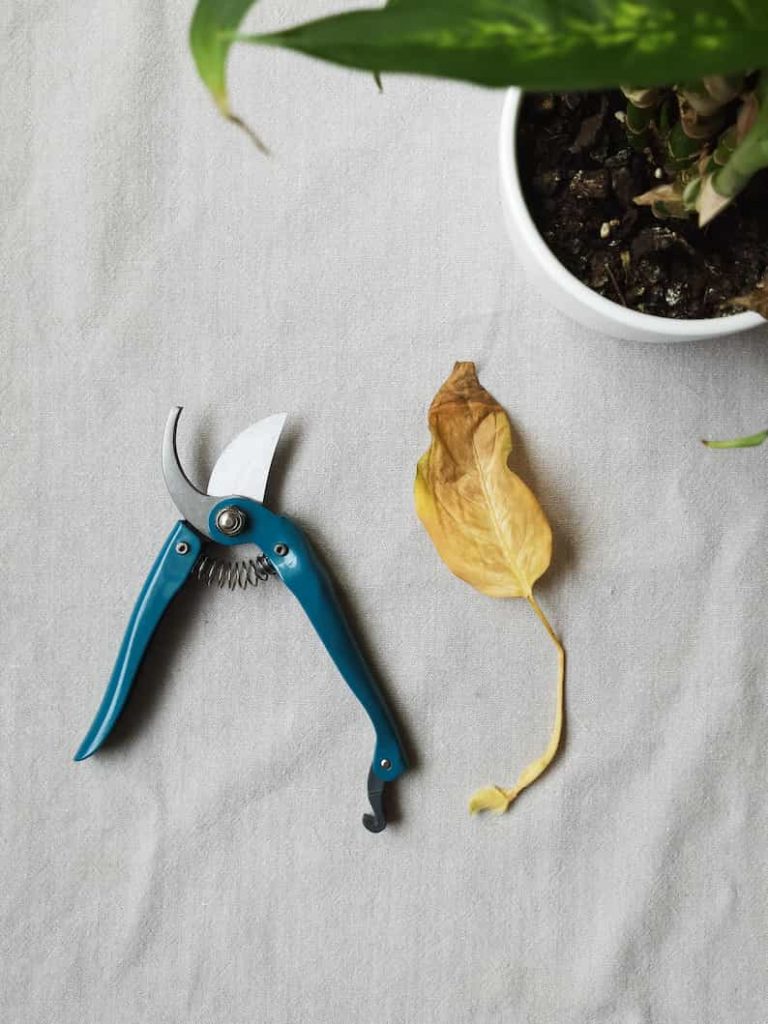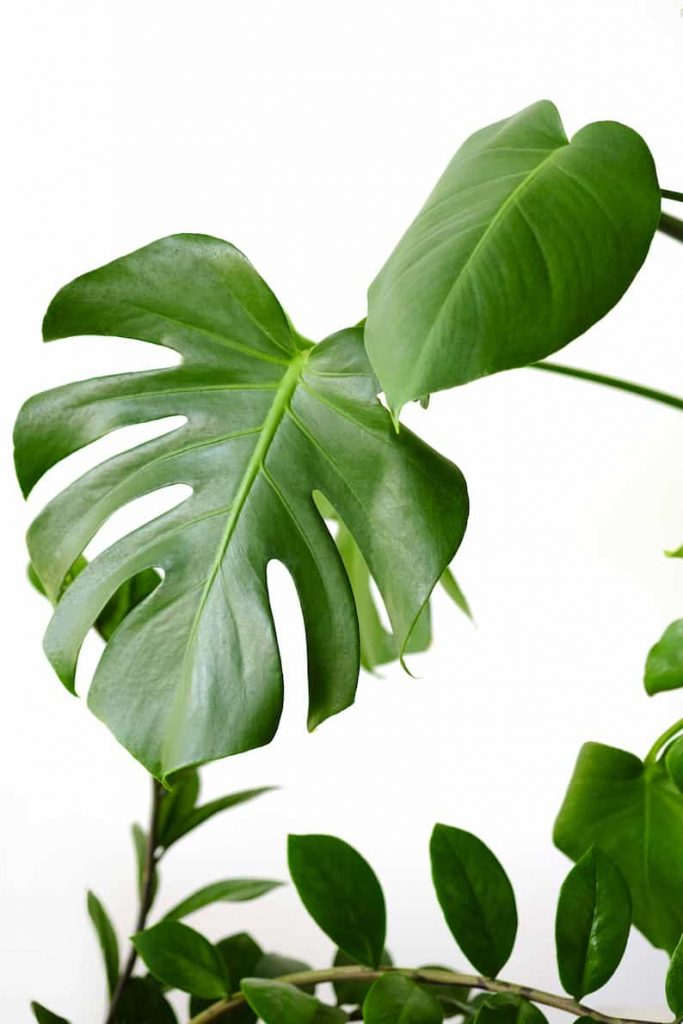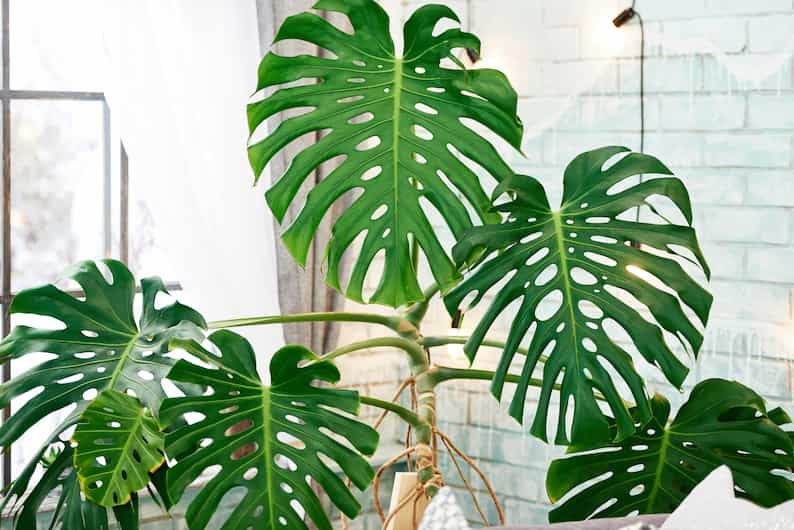Monstera plants make a lovely addition to your houseplant collection. And while most people choose these tropical plants for their striking foliage with its holes and splits, their incredible growth often comes a close second. However, with that growth eventually comes the need to cut them back – but do you actually know how to prune a Monstera to encourage growth?
That is, your Swiss Cheese plant (as they’re also known) is relatively easy to care for, although it does need some TLC to keep it healthy. Grow your Monsteras in a place where they receive bright light from a sunny window and keep their soil moist, and you will be rewarded with healthy growth that will make your guests swoon.
From there, if you are fortunate enough to have a flourishing plant that is outgrowing its location, or you just want to improve its shape, pruning an indoor Monstera is very easy.
Simply keep reading this article to see just how to trim a Swiss cheese plant to turn your overgrown Monstera Deliciosa into one that will soon be flush with new growth.

Table of Contents
How to prune Monstera to encourage growth
How you prune an indoor Monstera plant to encourage growth depends on your goals. Pruning off a few dead leaves is a different process than trying to control an overgrown plant. Likewise, pruning with the goal of propagating your Monstera plant takes a bit more care.
1. Removing yellow or dying leaves
As your Monstera plant grows and matures, older leaves yellow and die naturally. This is perfectly normal, and a few yellowing leaves are not a cause for concern (although if more than a few Monstera leaves are turning yellow, that may be cause for further investigation). However, to keep your Monstera plant happy and healthy it is important to prune off old and yellowed leaves regularly.
Use sterilized clippers (these pruning shears will do the job perfectly) or a sharp knife to cut the leaves at the main stem when pruning indoor Monstera. Follow the leaf stem back to the main branch and make a clean cut to remove it from the plant. Discard the leaves in the trash or in the compost bin as they cannot be rooted as a new plant.
2. Controlling or shaping an overgrown Monstera plant
Monsteras grow rapidly and can become unruly if they are left to their own devices. Lateral vines that grow aggressively may become disruptive and unattractive if allowed to grow wildly. To keep your overgrown Monstera Deliciosa plant in shape, you can prune wayward vines and direct new growth in the direction you prefer.
Identify offending vines before you begin to prune your Monstera. Follow the vine back to the main stem. Make a clean cut close to the main stem. Avoid cutting or damaging the stem.
These cuttings can be used for rooting or propagating your Monstera plant, but you will need to trim them again ½ inch below a node.
3. Root pruning
Root pruning is a technique used to slow down the growth of giant Monstera plants and keep them under control. While it may sound a little scary it is easy to do and when done properly will improve the health of your plant.
Remove your Monstera plant from the pot and examine the roots. You will see one main root with smaller lateral roots growing off it. The goal is to cut back the lateral roots by one-third and to leave the main root intact.
Gently tease the roots apart if they are tightly wound. Cut the ends of the lateral roots by no more than one-third the length of the root. This is a good time to trim away any discolored or damaged roots, too.

4. Pruning to propagate Monstera
Monsteras can be propagated with stem cuttings placed in moist potting mix or in a vase of water. But the cuttings need at least one node in order to root. That means you need to be selective when making node cuttings.
Select the tip of a vine with at least one or two healthy Monstera leaves attached. Follow the stem back to a leaf node. The node is the area where all new growth occurs. It will look thicker and may form a ring around the stem.
Make a clean cut ½ inch below the node with a sharp cutting instrument. Avoid using a dull blade for cutting as this can bruise the stem and cause tissue damage.
Should I cut back my Monstera?
Yes, cutting back unruly or overgrown vines on your Monstera is an effective way to control its growth. This also forces a flush of new growth. If your Monstera plant is overgrown or unruly, selectively cutting back vines and stems that extend beyond the borders of your plant will improve its appearance.
The leaves on your Monstera plants don’t live forever. Old leaves fade and die periodically as new growth replaces them. Cutting off or pruning old growth that is yellowing or dying is an effective way to promote the growth of healthy new foliage.
Keeping your Monstera plant trimmed to maintain the desired shape is good for the plant as it promotes new growth. After all, your Monstera leaves will grow back even if you cut them off.
When should I prune Monstera?
The best time to prune a Monstera is in early spring just before new growth begins. This ensures your plant will have the resources it needs to recover from any stress from pruning and to send out a flush of new growth.
Monstera plants enter dormancy in the fall and winter and take a rest after a season of active growth. The plant doesn’t stop growing altogether, but growth is minimal throughout the fall and winter.
Due to the decreased sunlight in winter, photosynthesis slows down. Your Monstera plants can’t convert as much of the sun’s energy into usable carbohydrates for active growth until the sun comes back out, which is why new growth begins again in the spring.
Where can I cut Monstera?
Where you cut your Monstera depends on why you are pruning it. To remove old leaves, simply cut them from the main stem. However, if you intend to use the pruned sections from your Monstera for propagation, the cutting needs to have at least one node. In that case, cut the stem half an inch below a node.
In the case of yellowed leaves, they are beyond saving and can’t be used for rooting or propagating your Monstera. After all, you can’t propagate Monstera without a node. That’s because nodes are the only place on the stem that can produce new growth as the section between nodes, called internodes, will not root or sprout new growth.

To locate a node, look for the area where leaves or your Monstera’s aerial roots grow. This area is thickened and may form a slightly raised ring around the stem. From there, once you’ve cut just below the node, root the cutting in a glass of water or in a moist potting mixture.
If you are pruning roots to control the size and growth of your Monstera plant, make sure you only cut the lateral roots. The main root, which is thicker and sturdier, should not be pruned or trimmed. Cut off one-third of the length of lateral roots when you are pruning the roots.
Should I cut off small Monstera leaves?
You can cut off small Monstera leaves, especially if you’re worried that they’re taking too much of your plant’s resources and want to encourage growth. However, small leaves on your Monstera plant usually signal that its growing needs are not being met and so pruning Monstera small leaves will not solve the underlying problems causing this.
Instead, a change in location, watering your Monstera only as often as it needs it, and proper nutrients will encourage your Monstera plant to produce larger leaves. To correct issues with small leaves, make sure your Monstera plant’s growing needs are met. Here’s a brief review of everything a Monstera plant needs to produce big, lush leaves and healthy growth.
- Light – Monstera plants thrive in bright light from a sunny window. While they can tolerate full sun from an eastern window, they cannot tolerate direct sunlight from a western or southern window. Check that your Monstera plant is receiving bright, indirect light for at least 6 hours a day.
- Water – Monsteras can be fussy about the amount of water they need to thrive. They do best in evenly moist soil that is allowed to dry out in the top 2 to 3 inches of the pot between waterings. Avoid over or under watering your Monstera plant by getting into the habit of checking the soil moisture frequently and watering it when the top inch or two is dry.
- Fertilizing – Like other plants, Monstera plants need nutrients in the soil to flourish and often suffer from too little or too much fertilizer. Feed your Monstera plant once or twice a month with a balanced houseplant fertilizer during the spring and summer. However, there’s no need to fertilize your Monstera in the fall and winter when your Monstera plant is dormant and resting.
- Humidity – As a tropical plant, Monstera needs high humidity levels to thrive. This is most commonly an issue in the winter when your home’s air is dry. Use a humidifier or pebble trays to raise the humidity level near your Monstera plants.
How to cut yellow leaves off Monstera
To cut yellow leaves off Monstera, follow the leaf’s stem back to the main branch or stem. Clip the leaf stem close to the main stem or vine. Then toss the old leaves or add them to the compost bin, as yellow leaves cannot be used for rooting and will not sprout new growth.
Cutting yellow leaves off Monstera should become a routine procedure for keeping it looking good. Older leaves yellow and die naturally as they are replaced by new growth. Cutting them off the plant is a simple procedure.
What happens if you cut a Monstera leaf?
Cutting Monstera leaves should be part of your regular plant care routine, especially if they are turning yellow, and so is actually good for your houseplant. If you accidentally cut a Monstera leaf though, don’t worry as it will more than likely grow back if the plant is healthy.
Many plant lovers are anxious to save cuttings from their plants to root and propagate the plant. While it is possible to use the leaves of some plants, like African violets and begonias, to create new plants, that is not the case with Monsteras.

Monstera leaves will not form roots or produce new shoots. The only part of a Monstera plant that produces new plant tissues is a node. Nodes are located on the main or lateral vines of the plant, but leaf stems do not have nodes.
If you accidentally cut a leaf off your Monstera plant, throw it in the trash or add it to the compost pile.
How do I shape my Monstera?
Shaping your Monstera plant is done by selectively pruning stems and vines. Sometimes you will want to trim off vines that have grown unruly to maintain the overall shape of the plant. Other times, you may want to force new growth in a particular part of the plant.
Removing wayward vines
If your Monstera is beginning to look a little like the jungle it was born in, you can reel it in by selectively pruning off wayward lateral vines. Examine the vines closely to determine which can be saved and directed up your Monstera pole and which are better cut from the plant.
Cut the vines to the desired length with a pair of sharp garden shears or other cutters. You can cut the vine back to the main stem if you desire, but you can also cut it anywhere along the length of the vine. Make the cut above a leaf node to encourage new growth along the vine.

Forcing new growth for dense foliage
If your Monstera plant looks spindly or lacks the lush foliage you desire, you can prune Monstera to encourage new growth. Providing your Monstera’s growing needs are being met, selective pruning can force new growth and create a more compact plant.
- Examine your Monstera plant closely to determine where you would like new growth to appear.
- Select the stem or vine that you would like to sprout new foliage.
- Locate a leaf node on the stem and make a clean cut just above the node. This will force new foliage to sprout and grow along the vine.
How do I fix my leggy Monstera?
Legginess occurs when your Monstera plant is not getting enough light to perform photosynthesis properly and to produce the carbohydrates the plant needs for healthy growth. As such, to fix a leggy Monstera, check that the light hitting your Monsteras leaves is bright enough to cast a fuzzy shadow.
Monsteras love bright light from a sunny window and suffer in low light. That’s why leggy Monsteras look like they are stretching towards the sky – as that is exactly what they are doing. This is partly because the light issue may be that the intensity of the light is too low.
How bright the light isn’t the only thing that matters to a Monstera. The duration of light is important too. To know if your Monstera is getting enough light, a good starting point is to check that your Monstera is receiving bright light for at least six hours a day.
Should you prune a leggy Monstera plant?
Pruning a leggy Monstera plant is a good idea. Because cutting or pruning a vine or stem just above a node forces new growth along the stem, doing this can force new growth and will improve the appearance of the plant.
But, beware: New growth will only sprout at nodes and will not grow from the internodes, so make sure you prune Monstera above the node.

That said, pruning a leggy Monstera won’t fix the legginess. Instead, the first step to correcting issues with legginess is to make sure your Monstera plant is getting the light it needs to thrive. At the same time, you may be able to improve the appearance of your leggy Monstera plant with some selective pruning, too.
Internodes are the long sections of the stem between the nodes. When plants stretch for light as your Monstera climbs, the internodes become elongated. This means pruning to force new growth will improve the appearance of your Monstera plant, but some sections of the vine or stem may still look sparse.
What do you do when Monstera gets too big?
Monsteras are known for their rapid growth and the tendency to reach impressive heights. If your Monstera has outgrown the limits of your space, there are several things you can do to control it.
1. Prune the lateral vine
If your major concern with a Monstera that has grown too big is how widely it has spread, you can correct that easily by pruning your Monstera’s lateral vines.
Lateral vines come off from the main stem of the plant sprouting new growth along the way. These vines can be trimmed back to the main stem or cut at any point along the vine. For best results make your cut just above a node.
2. Cut it back
If your concern is a Monstera that has grown too tall, topping it off or cutting it back may be the best solution. Follow the main vine or stem back to the desired height and trim it just above a node.
3. Prune the roots
A Monstera plant that grows too vigorously can be slowed down a bit with effective root pruning. Remove your Monstera plant from the pot and trim away one-third of the length of lateral roots. Lateral roots are thinner than the main root and spread out in all directions.
This can really help to avoid your Monstera becoming root bound.
4. Move your Monstera
If you are leery of aggressively pruning your overgrown Monstera plant, moving it to a new location may be a workable solution for you. Perhaps that overgrown Monstera plant in your living room would be better off at the office where it has more room to grow.
Pruning your Monstera plant to encourage growth might seem a little intimidating at first, but it really isn’t anything to fear. If you are uncomfortable beginning the task, start slow and take a few cuttings for rooting and work your way up to pruning to maintain the shape and height of your Monstera over time.
Think of pruning as a routine task like getting a little trim from the hairdresser. It is necessary to keep your plant looking good, but it doesn’t need to be a major undertaking.
Final thoughts on how to prune Monstera
As you can see, learning how to prune Monstera to encourage growth isn’t that difficult. Just by keeping a few key rules in mind, pruning an indoor Monstera can be a simple task to help your previously overgrown Monstera Deliciosa look its best.
Of course, it’s normal to wonder how you prune an indoor Monstera if you haven’t done it before, as no one wants to go to trim a Swiss cheese plant and accidentally harm it.
But just by cutting back your Monstera (making sure you’re trimming above the node) from time to time, you’ll soon see how easily you’re able to shape it so it continues to look perfect in your home.
